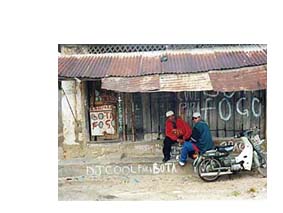|
|
 |
Hiphop in Tanzania Local hiphop artists that address social issues, like is being done at Bush Radio are not unique. In South Africa and elsewhere in the world, rappers have been aware of their potential role as reporters of what’s happening in their community.
 |
| Rappers Cool Para and Cool Muza on the baraza, a hangout for the youth. |
Outspoken
Hip-hop culture as it is known today developed in the United States from the mid-70’s on. It was first seen in the Bronx area of New York City in breakdance, graffiti mural art and most of all rap music. Rap developed at block parties and other informal settings, as well as in discos.
Lyrically, rap has strong roots in African-American oral traditions. In these first performances, the very localized content of rap had a strong appeal in the community; everybody was familiar with the slang, knew what the jokes were about.
Consequently, the rappers went a step further than conventional pop musicians in connecting to their audience. Moreover, the behaviour of fellow rappers, competitors and the audience was discussed in a critical, often humoristic way.
Since the New York hip-hop scene had no direct ties to the commercial music industry before 1979, its content wasn’t limited by censorship of curses or considerations of political correctness. Rappers (at the time also called ‘emcees’) could be very outspoken, and the audience was the most critical factor in the evaluation of a rapper’s message.
When the music industry started picking up on the trendy hip-hop culture and rap music in 1979, many of these features found their way into recorded raps and were picked up by artists from outside the region where hip-hop had originated.
Oppression
Around 1982, hip-hop artists started using their raps to discuss particular problems in their communities. An influential example is ‘The Message’ by Grandmaster Flash, which sold well all around the world and influenced rappers to put more community awareness into their rhymes.
By 1986, hip-hop culture was established internationally, with vinyl singles and albums, music videos and hip hop magazines being released and distributed as far as South Africa. This was also the time that rap groups like Boogie Down Productions released albums based on their philosophies.
They put strong emphasis on African-Americans taking pride in themselves, alternative ways of developing the community and looking critically at the oppression of black people in the USA and neo-colonial attitudes of the West towards Africa.
Others were less concerned with revolution and stressed the importance of their people’s historic ties with the African continent.
In this way, groups like the Jungle Brothers provided the audience in Africa with confirmation that they were also directly addressed in American hip-hop. Indeed, in the late eighties, many rap listeners in Africa would identify with the American hip-hop performers.
Protest against elders
In Tanzania, quite independently from the scene in Cape Town, a local variety of international hip-hop culture developed, again with lyrics focusing on the problems that urban youth face. However, Tanzanian rap developed in a different way from the Cape Town variety. It was never the voice of a racial or social minority.
Since Tanzania is not divided into classes and ethnically defined groups to the same degree as South Africa, rap emerged from the urban youth in general. In this way, it functions as a voice of the younger generation, and when that voice is raised in protest, it is mostly against their elders.
In the early nineties, the young generation had turned their backs on the socialist society, which their parents helped to build and which in the 80’s had nearly collapsed. A lot of blame was put on politicians who had been in power for nearly three decades within the same power structure.
Artists like solo rapper Mr II voice the frustrations of a large segment of the population. However, his fan base is diverse, not confined to certain areas of town or specific income groups.
Swahili poetry
Rappers have sought active collaboration with NGOs and other possible sponsors. Kwanza Unit, a long-standing rappers’ collective, worked with the Red Cross to release a track calling for a peaceful society and an end to war.
Solo artist Soggy Doggy was hired by Population Services International in promoting condom use among secondary school students.
Rap ‘edutainment’ in Tanzania has been largely incidental, occurring in some rappers’ lyrics, or being used as a supporting medium in existing awareness projects.
Discussing social issues has been a long-standing trend in Tanzanian popular music. In the seventies, the government sponsored ‘dance bands’ to sing in promotion of the development of national unity, or to inform the public on certain health issues.
Today’s rappers seem to have inherited this spirit as much as the more revolutionary approach of American artists like Public Enemy. Since many youngsters are unable to speak or understand English fluently, their inspiration is drawn in part from the Swahili pop music of the past, even Swahili poetry.
An example is rapper Cool Para from Zanzibar who uses the metre of taarab lyrics, and whose lyrics are – quite unusually for a rapper – composed by an older poet who is also active in politics. At times, his message is almost a copy of the party programme of CCM, but at the same time, he is critical of politicians – within the limits of censorship in the Tanzanian media.
Recognition
As it became clear that Tanzanian rappers were voicing their constructive criticism in rap, the older generation has become more supportive than they used to be. The Tanzanian Arts Council has recognized rap as an official genre within Tanzania’s pop music, and urges young rappers to use their lyrics to discuss society’s problems, such as drugs, sexual abuse and lack of education.
However, the driving forces are still the members of the hip-hop community; the recent popularity of rap music has enabled them to organize themselves more successfully. One example of this can be seen in the young initiators of ‘PREACH/SEMA’, an organization promoting the discussion of social issues among youth. They have started organizing weekly rap concerts in which young people are free to present their raps, and have held rap festivals focusing on raising AIDS awareness.
The recent project involving a conference and workshops in Dar es Salaam that united rappers from Tanzania, South Africa and Holland was the first occasion on which an evaluation was held of rap’s function as a medium in Tanzania. Its possibilities and limitations were discussed.
Text: Thomas Gesthuizen. Gesthuizen is a committee member of Madunia Foundation (Development in music) He has been a consultant for the NiZA/Madunia HIVhop- project
| |
|
|

|
 |  |  |  |
|

